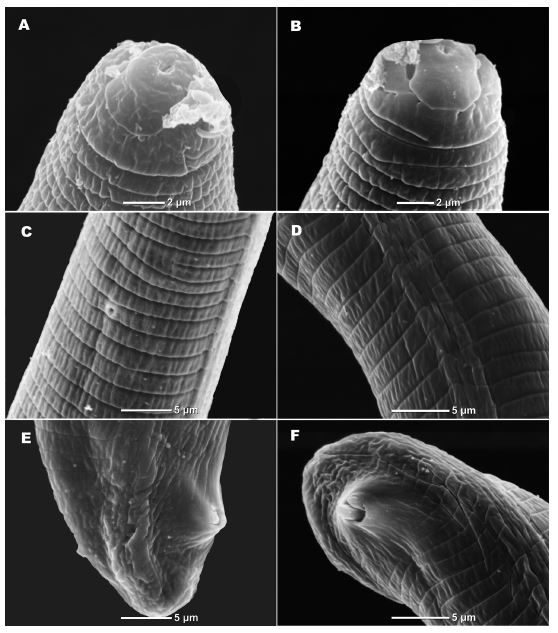Scanning electron microscope photographs of Meloidogyne minor.
In 2015, unusual yellow patches began to appear on the grass at Hagley Oval, a beautifully maintained cricket ground located in South Hagley Park, Christchurch. This field, used for professional and international matches, had been recently laid with fresh turf—so when parts of the grass stopped growing properly, it prompted a deeper investigation.
Samples of the grass and soil were collected and examined by a team of scientists from Manaaki Whenua Landcare Research, the Ministry for Primary Industries, and AgResearch. What they discovered was both fascinating and concerning: a microscopic worm-like organism called Meloidogyne minor—a type of root-knot nematode never before recorded in New Zealand.
What Is a Nematode, and Why Does It Matter?
Nematodes are tiny roundworms, many of which live naturally in soil. While most are harmless (and some are even helpful), there is a group known as plant-parasitic nematodes that can cause serious damage to crops, turf, and pasture.
Among them, root-knot nematodes (Meloidogyne species) are especially destructive. They invade the roots of plants, causing small galls or “knots” that interfere with the plant’s ability to take up water and nutrients. The result: stunted growth, poor yields, and unhealthy-looking turf or crops.
Meloidogyne minor is one such species. First described in the Netherlands in 2004, it has since been found in the UK, Ireland, USA, Belgium, Portugal, and Chile. It can attack a wide variety of plants, including potatoes, carrots, tomatoes, lettuce, and turfgrasses like perennial ryegrass.
The Discovery at Hagley Oval

In Christchurch, the team found signs of yellow patch disease on the grass. Upon close examination, they discovered large numbers of M. minor juveniles—over 7,800 in just 80 grams of soil. That’s well beyond what is considered a harmful threshold for plant health.
This was a significant find: not only was it the first record of M. minor in New Zealand, it was also one of only two known records in the entire Southern Hemisphere at the time.

Confirming the Identity
To confirm the species, the researchers used two main methods:
- Morphological study – They examined the nematodes under microscopes, carefully measuring their features and comparing them to known species.
- DNA sequencing – Genetic material was extracted from individual nematodes and compared to international genetic databases.
The results showed a strong match with M. minor specimens from Europe and the Americas, both in body structure and genetic profile—though some small differences were noted in sensory organ positioning.
How Did It Get Here?
The origin of M. minor in New Zealand remains uncertain, but it likely arrived in contaminated soil—possibly via imported grass, equipment, or even footwear from overseas sports fields. Soil on golf shoes, for example, has been shown to carry nematodes across borders.
Following the discovery, further surveys were conducted across golf courses, parks, and turf supply areas around New Zealand. Fortunately, M. minor was not detected at any other sites. However, another nematode, Meloidogyne naasi, was found in some golf courses and stadiums, including in Auckland and Christchurch.
What Happens Next?
Eradicating M. minor completely would be extremely difficult—and expensive. Experts estimated that full eradication using soil fumigation could cost over NZ$30 million, with little guarantee of success. Instead, the team recommended a long-term management strategy, which included:
- Reducing nematode populations using nematicides (chemical treatments),
- Strict hygiene practices to prevent spread (especially through equipment and footwear), and
- Continued monitoring and research.
Why This Matters
This discovery is a reminder of how easily microscopic pests can spread in a globalised world—and how important it is to stay vigilant. Even highly maintained sports grounds like Hagley Oval can become entry points for new biosecurity risks.
The research team not only documented the first case of Meloidogyne minor in New Zealand, but also provided clear morphological and molecular data to help identify this species. They developed a diagnostic key to distinguish it from the other root-knot nematodes already present in the country.
So next time you walk across a cricket field or golf course, remember—there’s an entire microscopic world underfoot. Some of those tiny organisms are friends to plants, but others, like Meloidogyne minor, can cause damage that isn’t visible until it’s already widespread.

